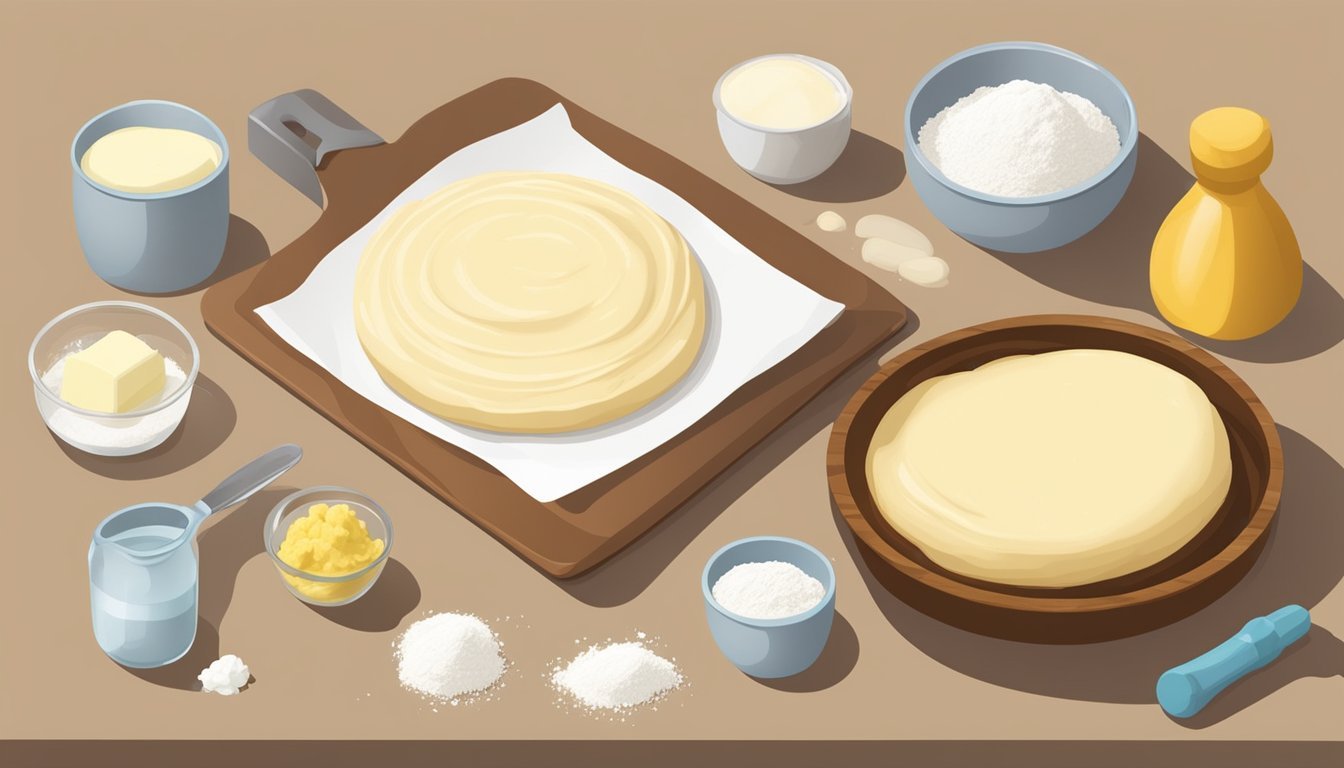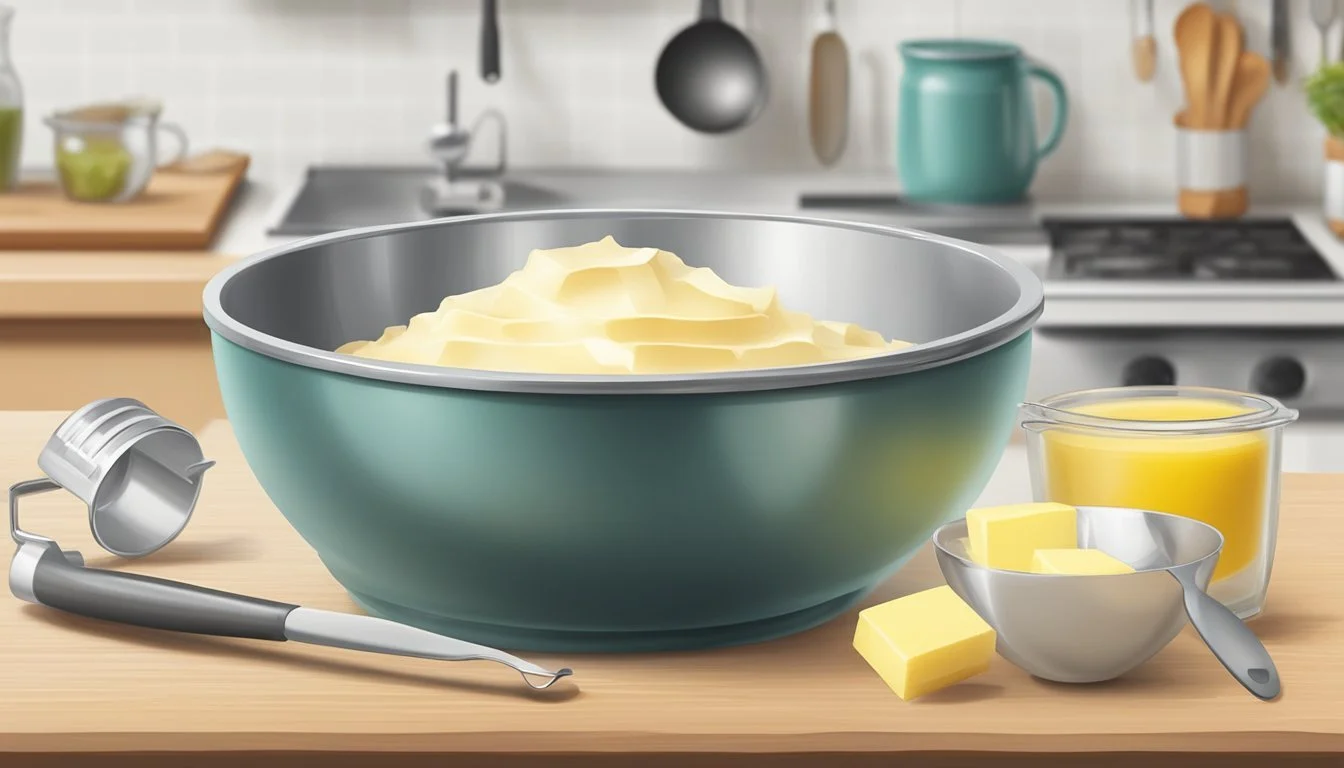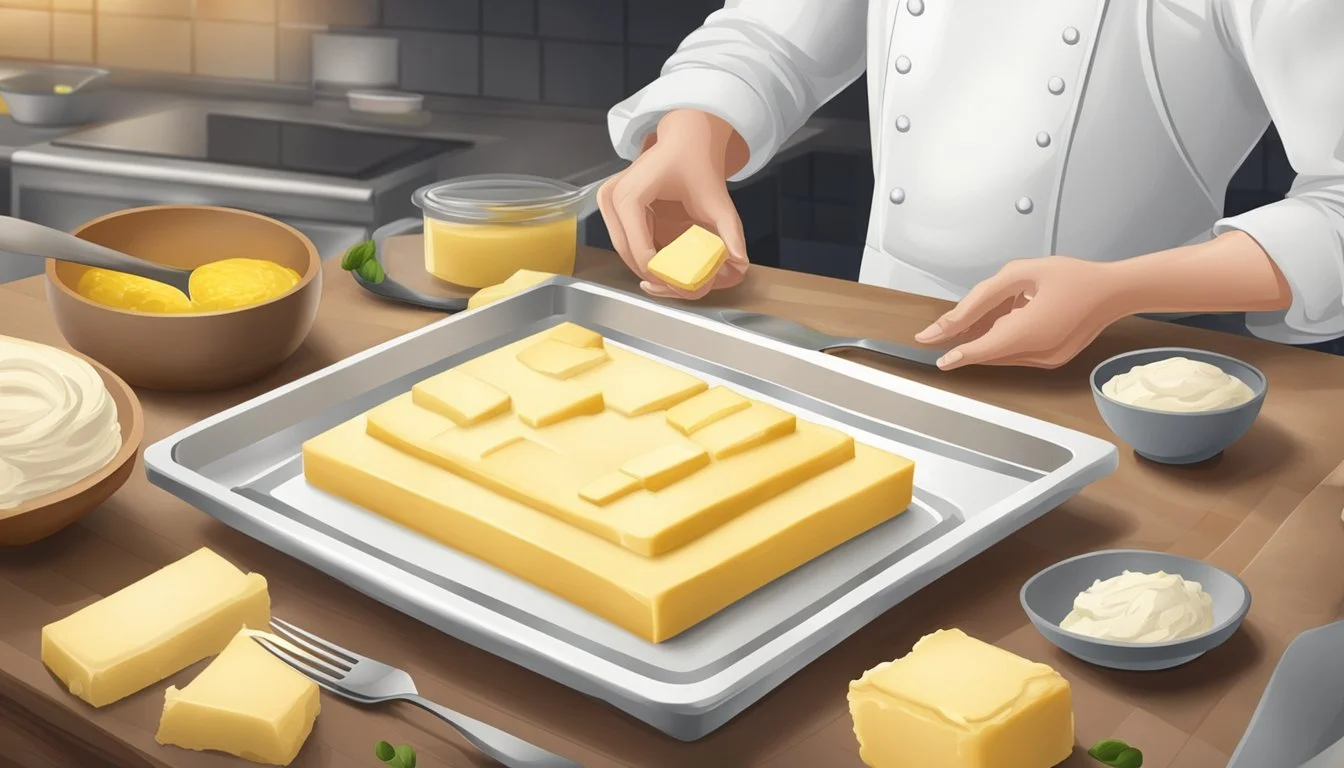How to Substitute Lard for Butter in Pastry
Mastering Flaky Textures
Substituting lard for butter (how long does butter last?) in pastry recipes is a practice that dates back centuries, when lard was a common staple in kitchens. In contemporary baking, lard is valued for its ability to create flaky, tender pastry textures that are often difficult to achieve with butter alone. Unlike butter, which contains water and milk solids, lard is pure fat, which contributes to the distinct texture it lends to pastry crusts.
While lard and butter can often be used interchangeably in pastry recipes, bakers should be aware of the slight differences they may introduce in texture and flavor. When lard replaces butter, the resulting pastry may have a better rise and a crumblier texture, but might lack the rich flavor that butter provides. Depending on personal preferences or dietary restrictions, this substitution could be beneficial to the final product.
Knowing how to properly substitute lard for butter is crucial to maintaining the desired outcome of your pastry. The process may require adjustments such as chilling the dough to prevent stickiness, or adding small amounts of flavor to compensate for the flavor butter typically imparts. A successful substitution hinges on the baker's understanding of these nuances and the willingness to experiment to achieve the best results.
Understanding Fats in Baking
In the realm of pastry, the type of fat used is integral to the texture, flavor, and structure of the final product. The choice between using butter or lard can have profound effects on these characteristics.
Roles of Fats in Pastry
Fats play multiple critical roles in pastry. They act as tenderizers, breaking up gluten strands to create a more tender crumb. In addition, fats can trap air when creamed, aiding in leavening and adding volume to baked goods.
Tenderizing: Fats interfere with gluten formation, lending tenderness to pastries.
Leavening: When fat is creamed with sugar, it traps air, which expands during baking for a lighter texture.
Fat Content and Its Effects
The fat content of butter and lard is distinct, leading to differences in moisture content. Butter contains about 80-85% fat and about 15% water, while lard is 100% fat. This difference in moisture can affect the dryness of pastry.
Butter:
80-85% fat
Remainder is mostly water, which contributes to steam and can affect puffiness in pastries.
Lard:
100% fat
Absence of water means it can produce a flakier texture but less lift compared to butter.
Comparing Lard and Butter Properties
Butter is known for its rich flavor that it brings to pastry, courtesy of milk solids and water content. Lard, on the other hand, is prized for its ability to create flaky layers due to its higher melting point and pure fat content.
Texture:
Butter: Results in a softer pastry with potential for layers.
Lard: Ideal for flakiness, especially in pie crusts and pastries, due to a higher melting point.
Flavor:
Butter: Imparts a rich, buttery flavor.
Lard: More neutral, allowing other flavors in the pastry to stand out.
Structure:
Butter: Can help create a cake-like structure in baked goods.
Lard: Its lack of water leads to a different structure, potentially making pastry crumblier.
Substitution Basics
When substituting lard for butter in pastry recipes, one must consider the fat proportion and the water content to maintain the desired texture and flavor of the final product.
Lard to Butter Ratio
In terms of fat content, lard and butter are not equivalent; thus, the right ratio is crucial for substitution. A general guideline for substitution is as follows:
Butter to Lard: Replace 1 cup of butter with 7/8 cup of lard.
This ratio accounts for the higher fat content of lard compared to butter. Pastry chefs need to adjust proportions to ensure the recipe retains its intended quality.
Adjusting for Water Content
Butter typically contains about 15-20% water, which is absent in lard. This difference in water content can affect the moisture level of the pastry. To compensate for this, one can add additional liquid to the recipe. The adjustment can be summarized as:
For every 1 cup of lard used, add approximately 2 tablespoons of liquid (water or milk).
This adjustment helps to balance the dough's consistency, preventing it from becoming too dry. When making these adjustments, bakers should consider the specific requirements of each recipe, as the exact proportions might vary slightly based on other ingredients and desired texture.
Executing the Substitution
When substituting lard for butter in pastry recipes, precise preparation, mixing, and chilling techniques are essential to achieve the desired texture and flavor of the crust. The following guidelines will ensure successful pastry dough execution with lard as the substitute for butter.
Preparation Tips for Baking with Lard
Before one starts baking, ensure the lard is chilled. This helps maintain its structure during mixing and rolling, which is crucial for a flaky crust. There are a few steps to prepare:
Measure accurately: For every cup of butter that the recipe requires, use the same amount of lard.
Keep it cold: Lard must be kept in the refrigerator until it's time to mix. This prevents it from becoming too soft and oily, which would negatively affect the dough.
Mixing Techniques for Pastry Dough
The way one mixes lard into the flour is key to achieving the right pastry texture:
Cut the lard into the flour: Use a pastry cutter or two knives until the mixture resembles coarse crumbs.
Be gentle: Overmixing may result in a tough crust. Mix just until the ingredients come together.
Maintain ratios: Using a 1:1 ratio for the substitution often works well, but adjust if needed based on the recipe.
Chilling and Resting Dough
After mixing, chilling the pastry dough is non-negotiable for perfect pastry:
Wrap and chill: Once the dough is formed, wrap it in plastic and let it chill in the fridge for at least 30 minutes. This firms up the fat and relaxes the gluten developed during mixing.
Incremental cooling: If the recipe calls for pre-baking the crust, cool the shaped dough in the pie dish before baking to maintain shape and prevent shrinkage.
Longer baking time: Lard crusts may require a slightly longer bake time. Keep a close eye on it and adjust the time as necessary.
By applying these practical tips, one can seamlessly incorporate lard into pastry recipes traditionally calling for butter, resulting in a tender, flaky crust.
Specific Pastry Considerations
When substituting lard for butter in pastry recipes, one must consider the unique impacts on texture and flavor each type of fat can have for different baked goods.
Pie Crusts
In pie crusts, lard is often prized for its ability to create a flaky and tender texture. The high melting point of lard ensures that it remains solid longer, which helps create distinct layers of crust for that classic, flaky pie crust. This is due to the fat pockets that create voids in the dough when the lard melts during baking. For example:
Standard Butter Pie Crust: 225g butter
Lard-Substituted Pie Crust: 225g lard
Cookies and Biscuits
With cookies and biscuits, the difference becomes more nuanced. Butter lends a richness and pronounced flavor, whereas lard can sometimes produce a drier texture. Cookies and biscuits benefit from the flavor of butter, but swapping in lard may yield a crumblier, slightly savory bite. The substitution ratio is typically 1:1. Here, textural differences should be expected and embraced as part of the charm of using lard.
Cakes and Muffins
For cakes and muffins, the behavior of lard diverges more from butter due to its lack of water content and different melting characteristics. When substituting lard:
Expect a higher rise.
Anticipate a drier crumb.
To adjust, one might consider increasing the moisture of other ingredients to compensate for lard's lower moisture content compared to butter. The ratio here again is largely 1:1, but slight tweaks might be necessary to achieve the desired moistness and texture.
Alternative Fat Substitutes
When substituting lard in pastry recipes, one has the flexibility to choose from multiple fat alternatives depending on dietary preferences and flavor profiles sought. This section will explore vegetable-based alternatives, dairy-free and vegan options, and some less common fat substitutes to suit diverse culinary needs.
Vegetable-Based Alternatives
Vegetable oils, such as vegetable oil and olive oil, offer a liquid fat option that can be used in pastry recipes. Precisely, one can substitute 7/8 cup of vegetable oil for every 1 cup of lard. Olive oil, used in a 1:1 ratio, provides moisture but may impart a distinct flavor, thus it’s best used in recipes where its taste complements the overall flavor profile.
Coconut Oil: This option can replace lard in a 1:1 ratio and is solid at room temperature which helps in maintaining the structural integrity of pastries. However, one should consider the slight coconut flavor it may introduce to the dish.
Dairy-Free and Vegan Options
For those seeking dairy-free or vegan alternatives, several plant-based fats can work effectively as substitutes for lard.
Margarine: Most margarine varieties are vegan and can easily be used cup for cup in place of lard. It’s vital to select a high-quality non-hydrogenated margarine to achieve a texture similar to lard without unwanted trans fats.
Avocado: Mashed avocado can provide the required fat content for pastries, although it also adds moisture which may require recipe adjustments.
Uncommon Fat Substitutes
Exploring uncommon fats can yield some unique and satisfying results in pastry making.
Beef Tallow: An animal-based option like beef tallow could be utilized, though it is less common, and used at a 1:1 ratio, it may impact the pastry’s flavor profile and is not suitable for vegetarians or vegans.
Palm Oil: Much like lard, palm oil has a similar consistency and fat content, allowing for a 1:1 substitution ratio, though it carries environmental concern due to unsustainable farming practices.
Using these alternatives in pastry recipes can ensure a satisfactory outcome while catering to various dietary requirements and ethical considerations.
Health and Dietary Considerations
When considering substituting lard for butter in pastry, health and dietary factors play an important role. This section covers the implications of making such a substitution with respect to saturated fat content, dairy allergies and intolerances, and vegetarian and vegan concerns.
Saturated Fat Content
Lard and butter both contain high levels of saturated fats, although the specific content can vary. On average, butter contains about 51% saturated fat, while lard comprises about 39% saturated fat. Those monitoring their saturated fat intake should take note of these figures when making substitutions.
Dairy Allergies and Intolerances
Butter, a dairy product, can be problematic for individuals with dairy allergies or lactose intolerance. Lard is dairy-free and can serve as a suitable alternative for those avoiding dairy. However, confirmation that lard has not been hydrogenated is essential, as some hydrogenated lards contain trans fats.
Vegetarian and Vegan Concerns
Lard is rendered from pork fat, which excludes it from vegetarian and vegan diets. Those seeking a non-animal-based substitution might consider vegetable shortening, which is typically free from animal products, though one should verify if it suits vegan standards as some brands may contain animal-derived ingredients.
Practical Tips and Tricks
When substituting lard for butter in pastry, one must pay careful attention to storage, accurate measurements, and proper techniques to ensure baking success. Proper storage extends shelf life, precise conversions enhance texture, and avoiding baking mistakes maintains flavor and quality.
Storing Lard and Butter
Lard: It should be stored in a cool, dark place prior to opening and either in the fridge or freezer afterward to prolong its shelf life which can range from a month to up to a year if frozen. Butter: Typically has a shelf life of several weeks in the fridge and can last months if frozen. Keeping it wrapped and airtight is crucial to prevent odors from affecting its flavor.
Measuring and Conversion Quick Guides
Here is a quick reference for converting between butter and lard:
1 cup butter = 1 cup lard
225g butter = 215g lard (lard is denser, hence the slight reduction)
For precision, always use a kitchen scale or designated measuring cups for dry and wet ingredients, and remember, when baking, room temperature fats mix more easily.
Avoiding Common Baking Mistakes
Overworking dough can lead to toughness. Work fats into the flour until the mixture is crumbly.
Uneven heating can cause inconsistent texture in pastries; preheating the oven is essential.
Substituting lard 1:1 in place of butter without adjustments might alter the flavor; consider adding a pinch of salt if using unsalted lard to mimic butter's taste.
Advanced Techniques for Professionals
When substituting lard for butter in pastry, professionals often take a hands-on approach to ensure the highest quality of the cooking fat. They render their own lard and creatively use different fats to achieve the desired texture and flavor in high-end baking.
Rendering Your Own Lard at Home
Professionals understand that rendering lard from pork fat at home allows for control over the quality and purity of the ingredient. The process includes slowly cooking down the pork fat until it separates from impurities and turns into a clear, odorless fat. Chefs strain the liquid lard and cool it to create a smooth and consistent product. The key is to use fat from pastured pigs for the best flavor profile.
Steps for Rendering Lard:
Chop or grind the pork fat into small pieces.
Heat gently in a heavy pot on low to avoid scorching.
Stir occasionally and skim off any impurities.
Strain through cheesecloth into a clean container.
Cool until the lard solidifies.
Creative Use of Fats in High-End Baking
High-end baking involves a strategic approach to fat selection, which can significantly affect the pastry's flavor and texture. When substituting lard for butter, a professional baker may opt for a blend of fats to balance the rich flakiness of lard with the creaminess of butter.
Blending Fats for Optimal Results:
Pie Crusts: A mix of 75% lard and 25% butter can produce a crust that's both flaky and flavorful.
Biscuits: Using half lard and half butter yields a tender crumb with a pleasant mouthfeel.
Pastries: Depending on the desired outcome, adjusting the ratio of lard to butter can enhance both taste and structure.
Professionals might also experiment with small additions of other fats like duck fat or coconut oil for a unique take on traditional recipes, always aiming for a balance that upholds the integrity of the pastry's original texture and taste.
Conclusion: Embracing Versatility in Baking
In the realm of pastry making, the notion of versatility takes on a special significance. Bakers often find themselves in situations where traditional ingredients such as butter aren't available or suitable for specific dietary needs. In such cases, knowing how to effectively use substitutes like lard can be invaluable.
Lard as a substitute for butter has its own merits in pastry. While it's essential to understand that the textures and flavors imparted by lard will differ from butter, these differences can work to a baker's advantage. For instance, pastries made with lard typically exhibit a flakier texture, which is especially desired in pie crusts.
Here's a brief guide on substituting lard for butter:
Measurement: Substitute lard for butter in a 1:1 ratio for most recipes.
Texture: Expect a slightly drier and crumblier texture in cakes.
Flavor: Recognize that lard will impart a different flavor profile, which may be less pronounced than butter's.
Bakers should embrace these differences as an opportunity to experiment with new textures and flavors. For adaptability, bakers can even consider blending lard with butter, incorporating the best of both worlds: the butter's rich flavor with the lard's exceptional flakiness.
In conclusion, the ability to substitute lard for butter underlines a baker's prowess in adaptability. One's confidence in the kitchen grows with knowledge and experience, leading to a broadened repertoire in the art of baking.






